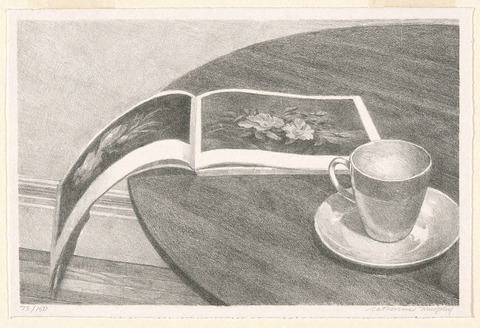
Foil Print Still Life
Catherine Murphy’s “Still Life With Reproductions” shows a table from the point of view of someone sitting at it. What do you notice about this still life? Look closer at the book. The images on the pages are floral arrangements. They’re still lifes within a still life! Murphy draws from direct observation instead of a photograph, often over long periods of time. Her art tends to focus on everyday things and turns them into art. She says, “How do you frame it… so that people see it?” How will you make the objects in your still-life painting look distinct?
For this Art at Home activity, try working with a friend (in person or virtually)! Gather two to four different objects from your house, and then arrange them on a flat surface into an interesting formation. Make sure these objects have a variety of textures, shapes and colors. After you have positioned your objects, paint what you see. A painting, print or drawing that shows a group of positioned objects is called a still life.
 Catherine Murphy (American, b. 1946), “Still Life With Reproductions,” 1974. Lithograph, 7 1/4 × 11 1/4 inches. Georgia Museum of Art, University of Georgia; Gift of Donald Droll. GMOA 1974.3264.
Catherine Murphy (American, b. 1946), “Still Life With Reproductions,” 1974. Lithograph, 7 1/4 × 11 1/4 inches. Georgia Museum of Art, University of Georgia; Gift of Donald Droll. GMOA 1974.3264.
For this activity you will need:
- Aluminum foil
- Paper
- Paint (Thick or slow-to-dry paint works best, but be creative. Watercolor will give you a more abstract work of art.)
- A paintbrush
To make your still-life print:
- Arrange your objects into a still life. Flatten out a sheet of foil on your work surface.
- Take a minute and observe your still-life objects. What do you see?
- Paint your still life as you see it onto the foil. Quickly apply the paint in a thick layer so that it doesn’t have time to dry.
- Take a sheet of paper and place it directly onto the wet paint on the foil. Press down gently over the entire sheet.
- Carefully lift the paper to see your print. What changed about your painting?
